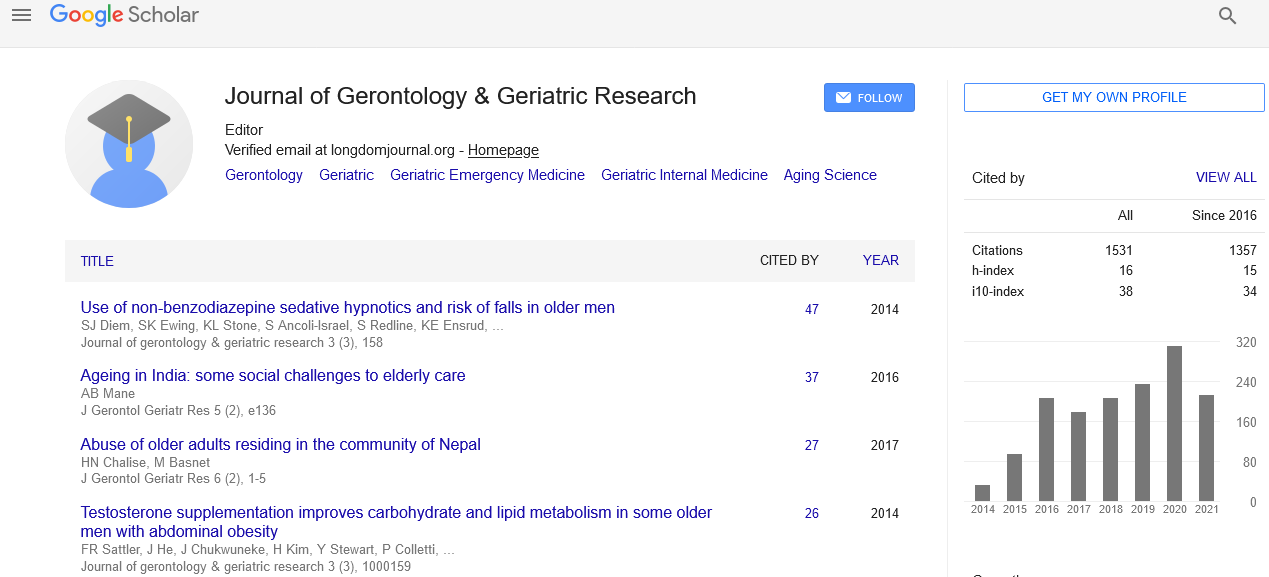PMC/PubMed Indexed Articles
Indexed In
- Open J Gate
- Genamics JournalSeek
- SafetyLit
- RefSeek
- Hamdard University
- EBSCO A-Z
- OCLC- WorldCat
- Publons
- Geneva Foundation for Medical Education and Research
- Euro Pub
- Google Scholar
Useful Links
Share This Page
Journal Flyer

Open Access Journals
- Agri and Aquaculture
- Biochemistry
- Bioinformatics & Systems Biology
- Business & Management
- Chemistry
- Clinical Sciences
- Engineering
- Food & Nutrition
- General Science
- Genetics & Molecular Biology
- Immunology & Microbiology
- Medical Sciences
- Neuroscience & Psychology
- Nursing & Health Care
- Pharmaceutical Sciences
Abstract
The New Challenge: The Aging Process in the Brazilian Amazonia
Henrique Schroeder Coelho, Poliana de Andrade, Juliana de Souza Almeida Aranha Camargo, Sergio de Almeida Basano, Ricardo Godoi Mattos Ferreira, Mariana de Andrade Coelho, Rubens Belfort Jr, Leandro Diehl, Pedro Gordan, Antonio Sergio Ferraudo and Luís Marcelo Aranha Camargo
There are few studies on the aging process in Brazil but no one focusing on the Brazilian Amazonia. In order to gain information about this issue, the University of Sao Paulo Research Unit in the state of Rondonia investigated the health status of more than 90% of the 412 elders over 59 years living in the urban area of Monte Negro city (63º22´W, 13°44´S). To this purpose, a cross-sectional study was done in July 2013, plus a review of all the death certificates of Monte Negro´s citizens between 2002-2011. These are preliminary results of cohort study that will follow up this group for the next 10 years. The initial results are shocking. Males accounted for 50.1% of the sample. Only 3.4% were born in the Amazon region and 48.6% were from Southeastern Brazil having arrived in Rondonia in the early seventies. More than 45% have never attended school. Regarding mortality information, more than 50% of the deaths were due to chronic non-transmissible diseases (CNTD) (cardiovascular disease, cancer and stroke), 30% were due to deaths linked to violent causes (mostly motorbike crashes), 18% were related to unknown causes and only 2% were related to infectious diseases. These figures are grossly like the profile of developed countries. The cross-sectional study gives us some more important information about the health status of this group: 70.6% have arterial hypertension and only 60% are receiving adequate medication. Dyslipidemia has a prevalence rate of 65.2% and just 12% are being adequately treated. Diabetes 2 prevalence is 22%, depression 11.6%, dementia 4.5%, and metabolic syndrome 45.4%. Reduced renal filtration rate (less than 60 mL/min/1.73 m2) occurred in 53.4%. The main ophthalmologic disorders were: cataracts 59.7%, glaucoma 11.6% and retinopathies due to diabetes/hypertension 2.4%. Fifty three percent of the patients were tested for transmissible diseases: 0.9% with hepatitis B, 0.4% with hepatitis C and no one with HIV 1 2 infection. At least one malaria episode was reported by 75% of the elderly, tegumentary leishmaniasis by 14.5%, leprosy by 4.3%and tuberculosis by 2.4% and Chagas disease by 0.7%.



